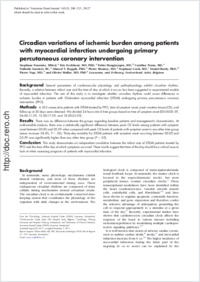Circadian variations of ischemic burden among patients with myocardial infarction undergoing primary percutaneous coronary intervention
- Fournier, Stephane Cardiology, University Hospital Center (CHUV), Lausanne, Switzerland
- Eeckhout, Eric Cardiology, University Hospital Center (CHUV), Lausanne, Switzerland
- Mangiacapra, Fabio Cardiovascular Center Aalst, OLV Hospital, Aalst, Belgium
- Trana, Catalina Cardiology, University Hospital Center (CHUV), Lausanne, Switzerland
- Lauriers, Nathalie Cardiology, University Hospital Center (CHUV), Lausanne, Switzerland
- Beggah, Ahmed T. Cardiology, University Hospital Center (CHUV), Lausanne, Switzerland
- Monney, Pierre Cardiology, University Hospital Center (CHUV), Lausanne, Switzerland
- Cook, Stéphane Cardiology, University of Fribourg and Hospital, Fribourg, Switzerland
- Bardy, Daniel Laboratory of Clinical Chemistry, University Hospital Center (CHUV), Lausanne, Switzerland
- Vogt, Pierre Cardiology, University Hospital Center (CHUV), Lausanne, Switzerland
- Muller, Olivier Cardiology, University Hospital Center (CHUV), Lausanne, Switzerland
-
01.02.2012
Published in:
- American Heart Journal. - 2012, vol. 163, no. 2, p. 208–213
English
Background: Several parameters of cardiovascular physiology and pathophysiology exhibit circadian rhythms. Recently, a relation between infarct size and the time of day at which it occurs has been suggested in experimental models of myocardial infarction. The aim of this study is to investigate whether circadian rhythms could cause differences in ischemic burden in patients with ST-elevation myocardial infarction (STEMI) undergoing primary percutaneous coronary intervention (PPCI).Methods: In 353 consecutive patients with STEMI treated by PPCI, time of symptom onset, peak creatine kinase (CK), and follow-up at 30 days were obtained. We divided 24 hours into 4 time groups based on time of symptom onset (00:00-05:59, 06:00-11:59, 12:00-17:59, and 18:00-23:59).Results: There was no difference between the groups regarding baseline patients and management's characteristics. At multivariable analysis, there was a statistically significant difference between peak CK levels among patients with symptom onset between 00:00 and 05:59 when compared with peak CK levels of patients with symptom onset in any other time group (mean increase 38.4%, P < .05). Thirty-day mortality for STEMI patients with symptom onset occurring between 00:00 and 05:59 was significantly higher than any other time group (P < .05).Conclusion: This study demonstrates an independent correlation between the infarct size of STEMI patients treated by PPCI and the time of the day at which symptoms occurred. These results suggest that time of the day should be a critical issue to look at when assessing prognosis of patients with myocardial infarction.
- Faculty
- Faculté des sciences et de médecine
- Department
- Médecine 3ème année
- Language
-
- English
- Classification
- Biological sciences
- License
-
License undefined
- Identifiers
-
- RERO DOC 29129
- DOI 10.1016/j.ahj.2011.11.006
- Persistent URL
- https://folia.unifr.ch/unifr/documents/302386
Statistics
Document views: 132
File downloads:
- pdf: 271
